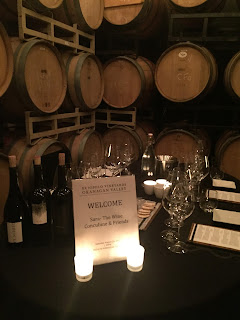"So why do Okanagan wineries generally produce whites like Riesling, Gewurztraminer and Pinot Gris?" My husband asked me on our annual trip there this past month.
Good question. And coincidentally, those three varietals he mentioned also happen to be 3 of the four Noble Grape varieties of Alsace, France.
Let's face it, the Okanagan isn't known internationally as a major region with high-demand, high-priced wines. But Alsace is located in one of the most well-known wine regions of the world: France. If all three of these varietals produce the majority of the wines made in both regions, can Okanagan whites can be just as good in quality as Alsatian wines? I am hoping to find out, so I made it my late summer project of 2013.
The Purpose: To compare and contrast the flavours and structural elements of the Okanagan aromatic white wines with the quality of the same Alsatian Noble Varieties via 3 blind tastings of each varietal from both regions (6 wines total). Can my husband pick out which wine is from which region?
The Grapes: Gewurztraminer, Riesling, Pinot Gris
The blind-tasting "Guinea Pig": My Husband. I won't be tasting blindly (someone has to pour the wine!), but will be taking subjective notes as if I didn't know what each wine was
Timeline: 2-3 weeks, with 3-4 blog entries devoted to the project
Alsace and the Okanagan have a few terroir-related things in common. They are both classified as having continental climates, meaning there is a wide temperature range between the warmest and coldest months of the year (the Okanagan has a much wilder temperature swing). Both regions generally experience hot, dry summers and longer-lasting Autumns, ideal for ensuring the grapes have reached both full and physiological ripeness, and provides ideal conditions for late harvest wines. Both regions are also known to have arid, drier conditions; Alsace is protected from wind and rain thanks to the Vosges Mountains, and the Okanagan lies between 2 mountain ranges, creating an arid, semi-desert micro climate. The soils are extremely varied in Alsace, also due to the Vosges mountains. The Okanagan's vineyards are planted on sandy loam or alluvial gravel soils. This could reflect the differences in the wines between the two regions, as well as other factors like vineyard practices and vinification techniques, which can vary from winery to winery. But if the climate is fairly similar, do the regions produce similar wines?
We started with Gewurztraminer, a wine that enthusiasts tend to either love or hate. Wine snobs generally stick their noses up at Gewurz - the HoseMaster of Wine refers to it as "The first choice of sommeliers everywhere to be left off the
by-the-glass list.", among other pretentious comments. However, women tend to love it for it's perfumed bouquet, slight sweetness and approachable, easy-to-drink nature.The German word for “spice", Gewurztraminer wines tend to be full-bodied, with an oily texture, low to medium acidity, and also can be high in alcohol, with aromatic notes of lychee, roses, and naturally, spice. Gewurz wines have proven to be a good match with turkey, spicy dishes like curry, and ladies' nights out. The 2 bottles we compared were Trimbach's 2010 wine (Alsace) against Sumac Ridge's 2012 Gewurz. Since I wasn't able to get both wines of the same vintage, I took into account the fact that Sumac's acidity may be higher and the flavours riper, whereas the Trimbach may be showing more signs of age (golden colour of the wine, smooth texture, etc). Both of the wines were bottled in the well-known "Flutes d'Alsace", a taller, thinner wine bottle with a long neck.
I found the Sumac Ridge Gewurz to have a complex and intense flavour profile of green apple, lychee, pineapple and blossom, along with well-balanced acidity. Although it needs a few years to settle a bit, it is drinkable now. My husband detected notes of nectarine & apple with a hint of minerality and crisp acidity.
The Trimbach Gewurz had the trademark oily texture with a rich, golden colour, smooth texture and flavours of pineapple, apricot and spice. My husband also found the Trimbach to be a thick and oily wine, with a bouquet consisting of green apple, blossom and honey.
We found that both wines had similar flavours; blossom, pineapple, the traditional lychee and green apple. Both wines also showed great body and flavour intensity, as well as intriguing complexity. The Sumac Ridge Gewurz showed a hint of minerality that the Trimbach did not have, and the Trimbach seemed to be more typical of a Gewurz wine with more aromatic flavours and the typical oiliness. When I asked my husband if he could pick out the Alsatian wine, he thought it was the Sumac Ridge.
All in all, my opinion is that Gewurztraminers from both regions have similar flavours and complexity and a few minor differences. But this is just my opinion. Despite the fact that some in the wine industry look the other way when it comes to this varietal, I recommend both of these wines for those who love Gewurz and the elements that make it what it is. Try it yourself and see what you think!
Up next: Trimbach vs Gray Monk: A Ries-slinging (like mud-slinging?) battle



